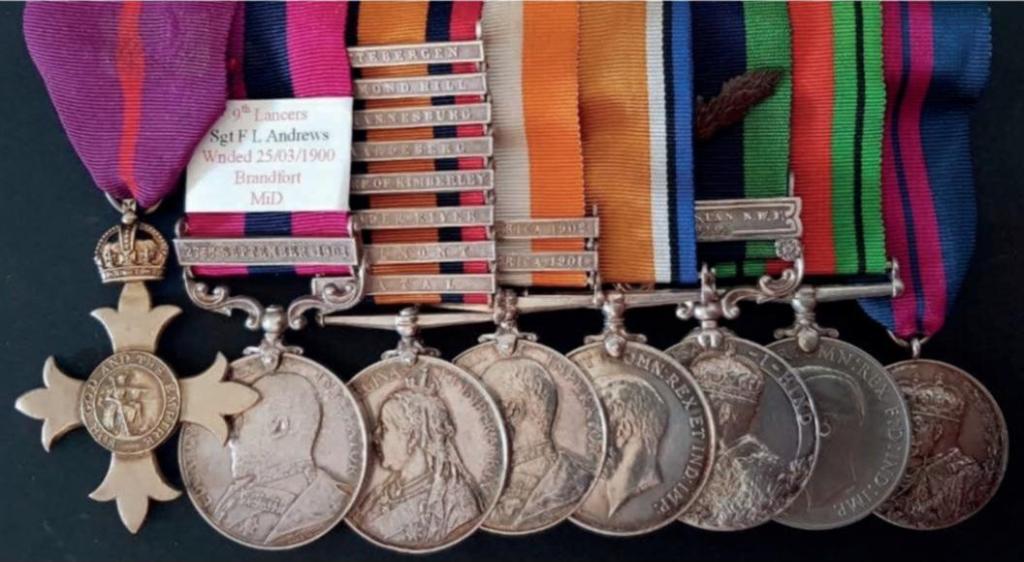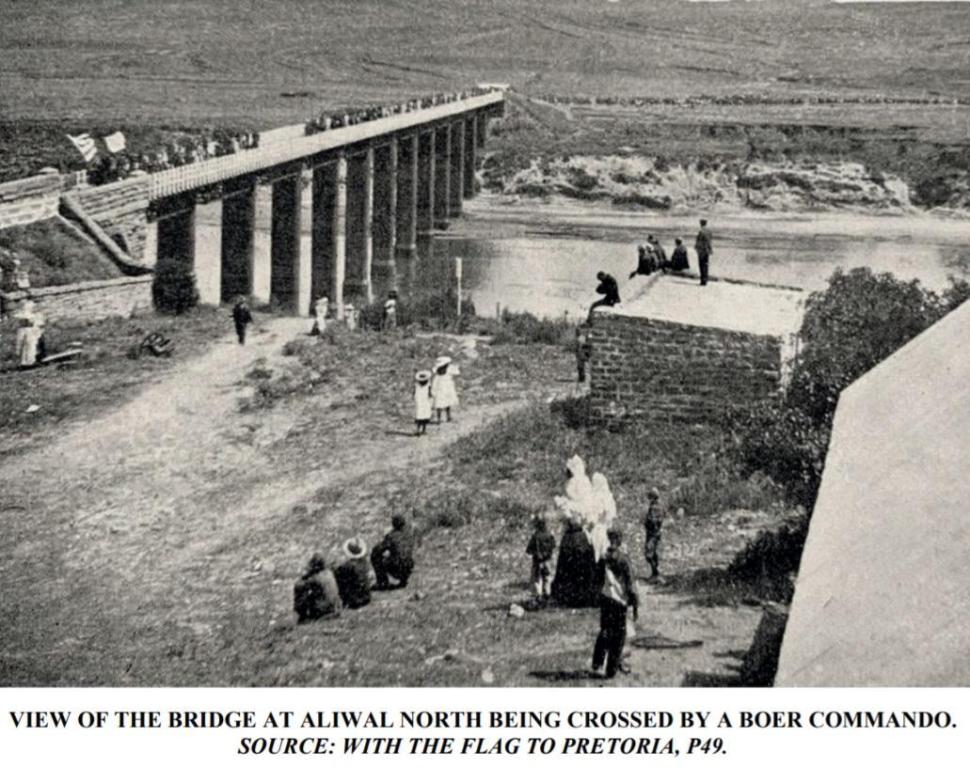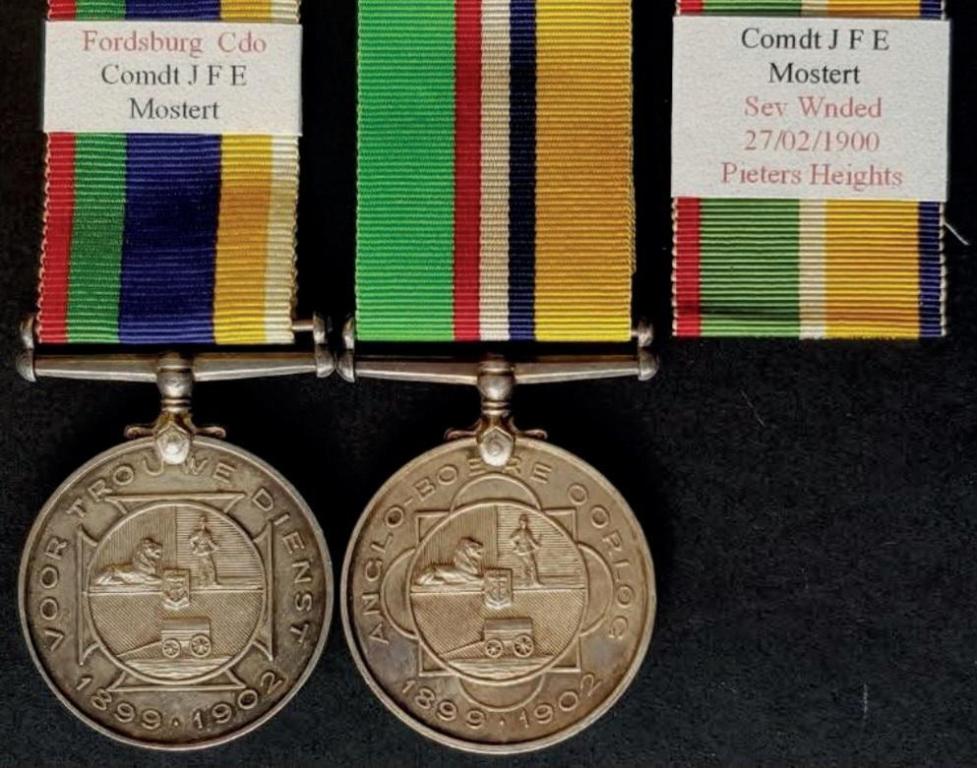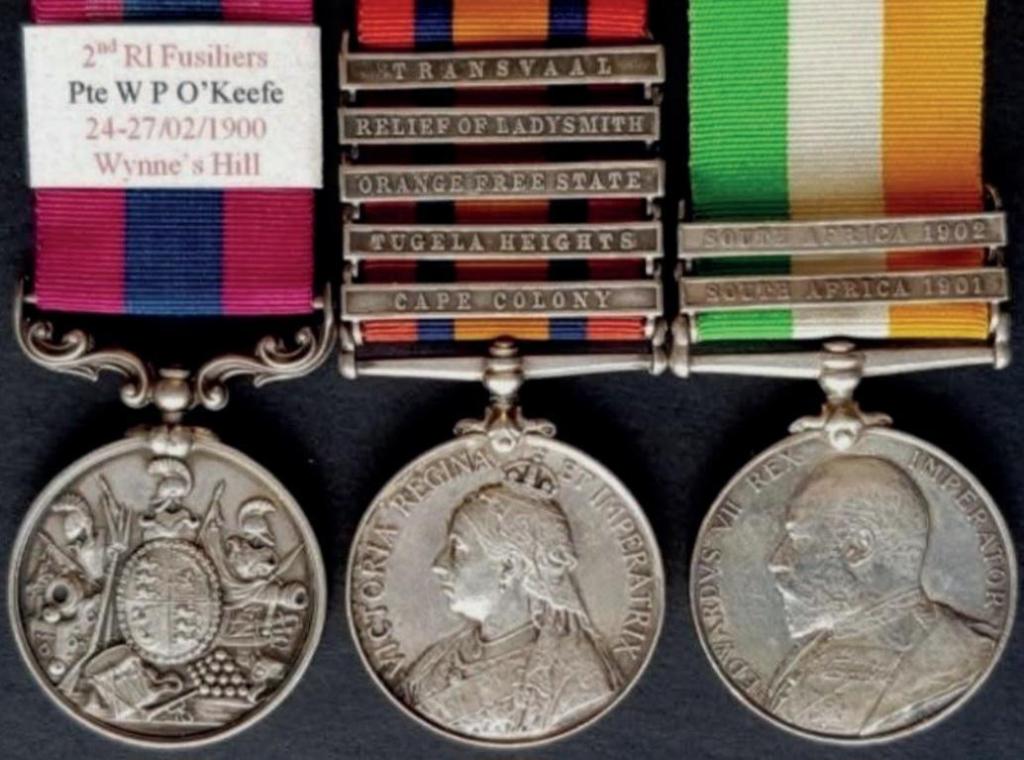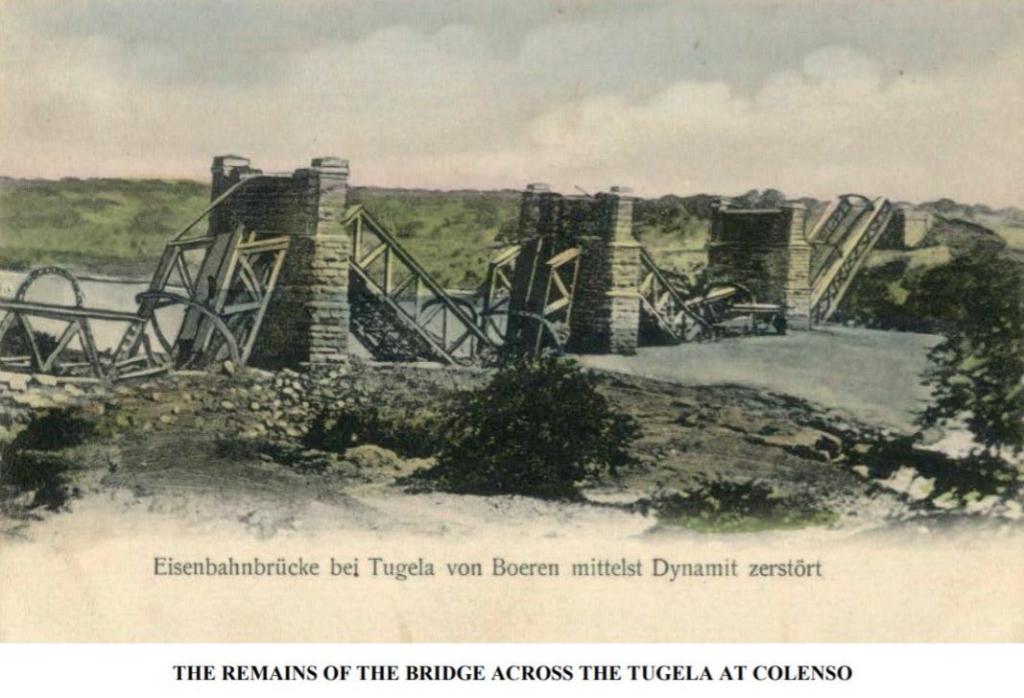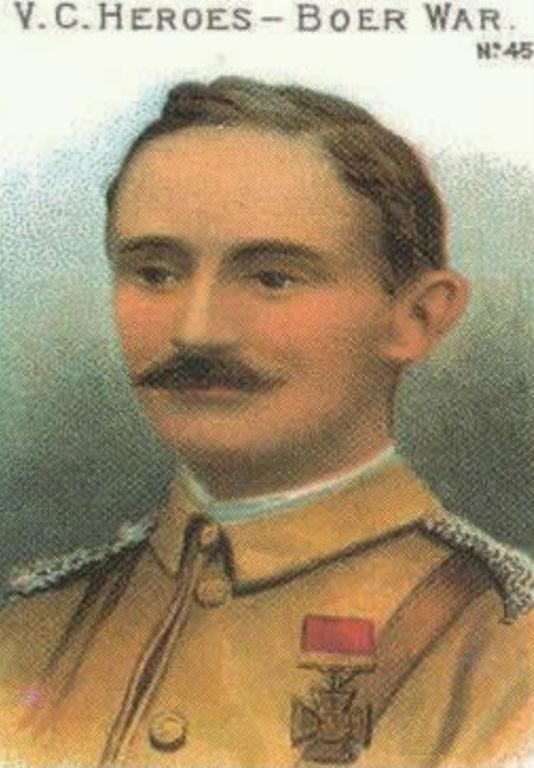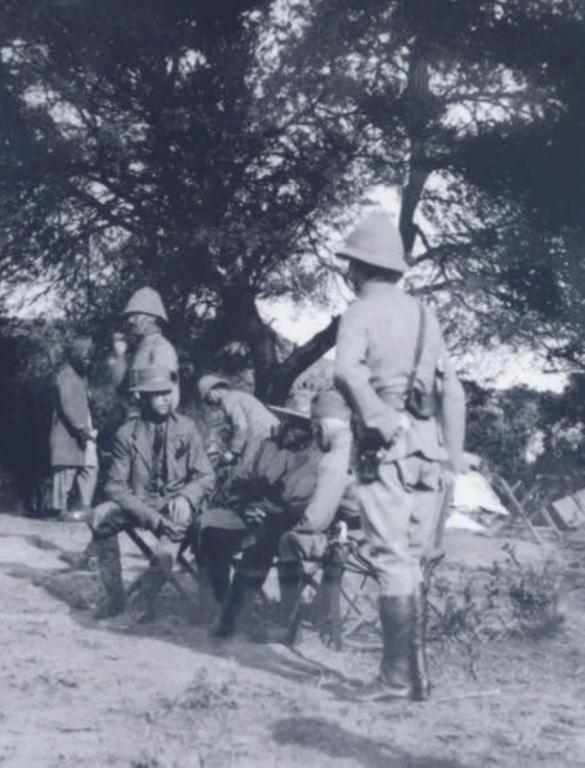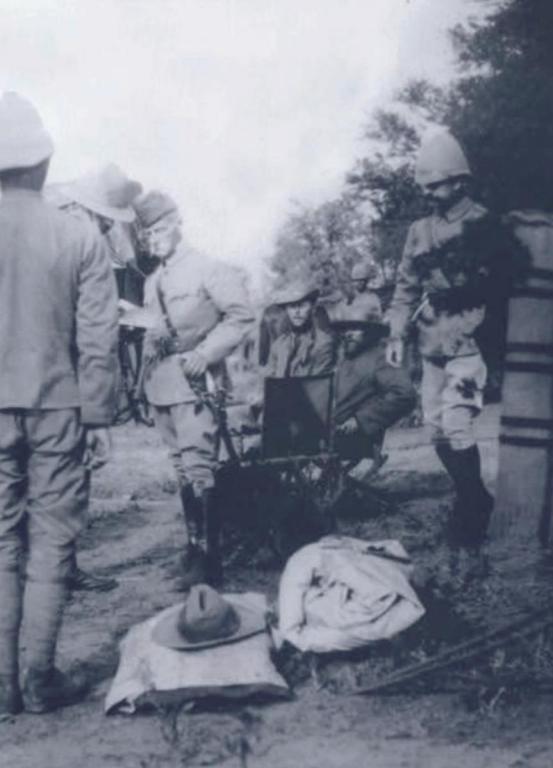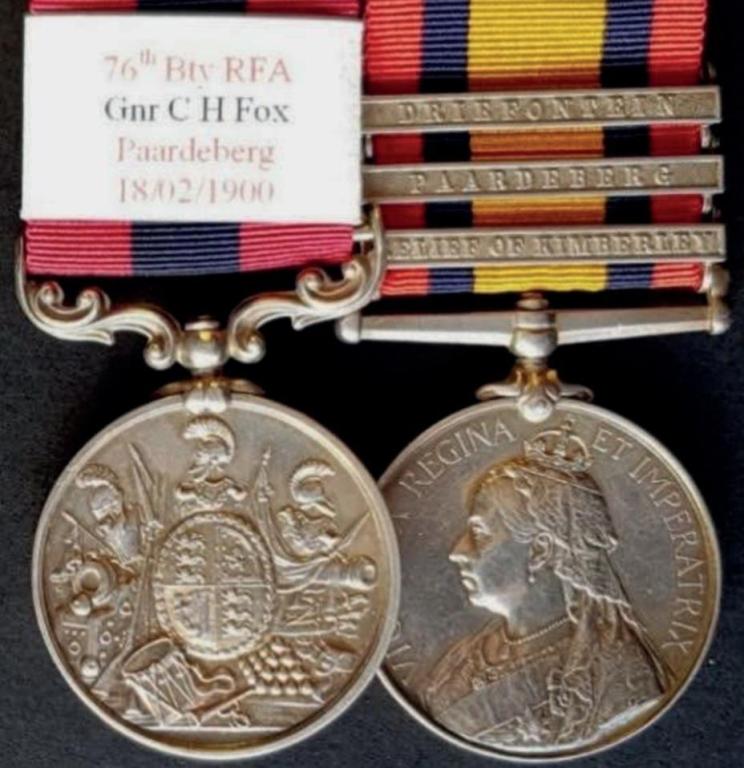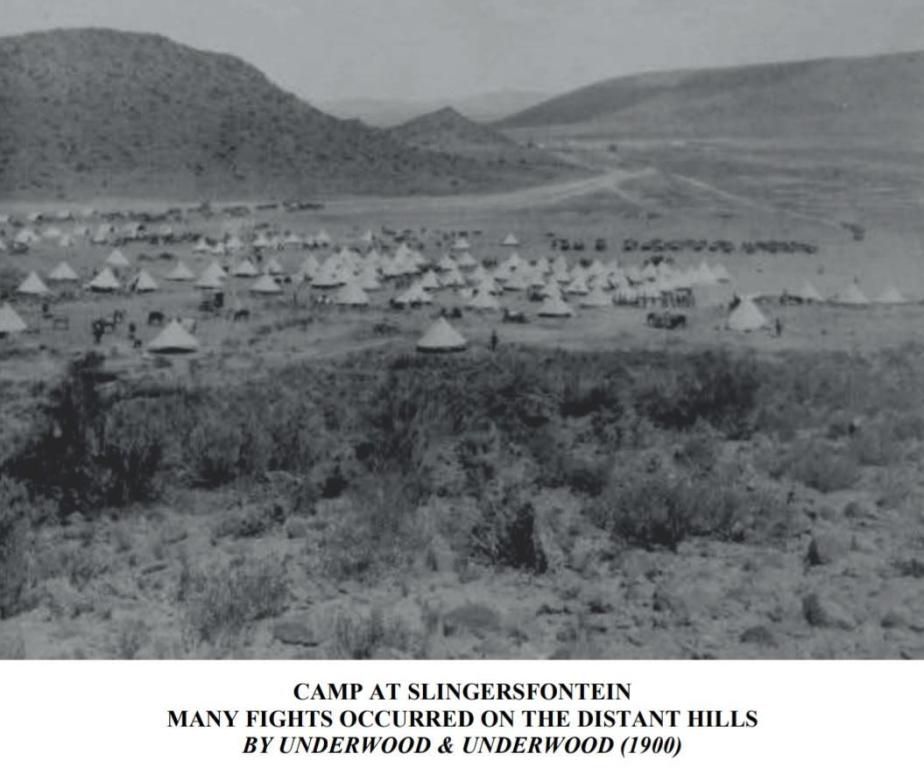-
Posts
1,593 -
Joined
-
Last visited
-
Days Won
14
Content Type
Profiles
Forums
Blogs
Gallery
Events
Store
Everything posted by archie777
-
“On the 31st he (Plumer) was within six miles of Mafeking but was driven back again to Ramathlabama by a large force of Boers of the Rustenburg and Marico commandos, reinforced by some Boers from Fourteen Streams. His casualties were eight killed, twenty-nine wounded (including himself), and eleven prisoners.” Times History, Vol IV, p207.
-
“General Tobias Smuts, with a force of about 2600 men, and Lieutenant-Colonel S P E Trichardt with 11 field-guns are ordered to cover Chief Commandant De Wet’s secret expedition to the Bloemfontein Waterworks near Sannaspost. Neither of them is familiar with the vicinity and they have to wait for guides before taking up their positions. Where they could have easily prevented it, the delay allows the British to cross the Modder River without opposition. In a desperate race for positions near Tafelkop, the burghers reach it first and the British cavalry is repulsed. They have to make a huge detour to work around the Boer flank while the infantry, supported by the artillery, occupy the enemy’s attention with assaults on their front. General Chermside’s Scottish Borderers, convinced that the Boers have been cleared out by the overwhelming barrage, are rudely disillusioned when the burghers open up from invisible positions in their front and completely shocked when Trichardt’s shells land among them. The British guns are pushed forward with every charge, but they remain inefficient in silencing either their counterparts or the enemy riflemen. On their flank Captain Danie Theron and seventeen of his scouts delay General Tucker’s vanguard, a unit of about 400 men, for most of the day – even taking the time to capture 100 oxen in the process. The action is inconclusive and General T Smuts returns to Brandfort when, at dusk, the Britich take heights west of the railway line and threaten their line of retreat. The British lose 30 killed, 155 wounded and five missing in action. Boers lose three killed and 18 wounded.” “The Anglo-Boer War: A Chronology” by Pieter G Cloete. The battle was important, nonetheless, in opening the way for Roberts to resume his advance across the northern half of the Free State and on to the Transvaal. Also see “War with Johnny Boer” p165.
-
“C” Squadron received orders to visit Brandfort, about 22 miles to the north, accompanied by one squadron of the 16th Lancers, under Capt. Sloane Stanley, who moved on the west side of the railway. Lieut. Duckett, with the advanced troop, got within about 200 yards of the town, and could see the people all coming out of church. Almost directly afterwards he came under heavy fire and had to retire back on the squadron. The Boers were collecting in some force and tried to get around the flanks, besides pressing them in rear. Lieut. Lord F. Blackwood’s patrol on the right flank was also nearly cut off, and the squadron had to make a running fight for ten miles. At one time, the “ C “ Squadron being somewhat pressed, Capt. Lund ordered a troop to face about and charge. This was well carried out and checked the Boers considerably. Sergt. Andrews and Corpl. Allin were both wounded during the retirement. Capt. Sloane Stanley was also wounded in the head, and the 16th Lancers had several casualties. Sergt. Andrews, Corpl. Green, Sergt. Hart, Ptes. Heanes and Shaw all brought men out of action and were reported for conspicuous gallantry. The squadron returned to camp at 7pm, having had a very hard day. “Diary of the Ninth Lancers in South Africa 1899-1902”by Colvin & Gordon. OBE (Mil) 1st type; DCM (EdwVII) with Second Award Bar, dated 27th September 1901: 3502 Serjt. F.L. Andrews. 9th Lancers; QSA, 8 clasps: Natal, Belm, Mod R, RoK, Paard, Jhburg, D Hill, Witt: 3502 Serjt. F.L.Andrews 9/Lcrs (engraved naming); KSA, 2 clasps SA’01, SA’02: 3503 S. Serjt.-Maj. F.L. Andrews. 9th Lancers; BWM: R.M. & Major F.L. Andrews; IGS1908-35, 1 clasp, Afghanistan N.W.F. 1919 with MiD oakleaf: Maj. F.L. Andrews, 7 Hussars; DM privately named: “Major F.L. Andrews, O.B.E., D.C.M.”; Cor GV 1911 privately named: “Lieut. F.L. Andrews, D.C.M.” OBE: Suppl LG 12 September 1919, p11460 “In recognition of distinguished services rendered in India in connection with the War.” DCM: LG 27 September 1901, p6305. As noted above Sergeant Andrews was wounded in the action at Brandfort on 25 March 1900 and reported for conspicuous gallantry in bringing men out of action. It can be assumed that he was awarded the DCM for the Brandfort gallantry. Bar to DCM dated 27th September 1901: LG 21 April 1903, correcting LG 31 October 1902, where he was listed for a second DCM in error. The error probably resulted from Lt-Col R W R Barnes’ recommendation in his capacity as O/C 2nd Regt. Imperial Yeomanry: “A most deserving case for recognition of services. He has been of the very greatest use to me as Regimental Sergeant Major and I have the highest opinion of his capabilities & reliability. He has been of great use to the 2nd I.Y.” In this undated WO document, he stated that Andrews had not received any previous awards or mentions. Frank Leon Andrews was mentioned in Lord Roberts’s despatch dated 4 September 1901 (LG 10 September 1901, p5929) and again in Lord Kitchener’s final despatch dated 23 June 1902, where he is listed as local Regimental Sergeant-Major, 2nd Battalion Imperial Yeomanry. He was commissioned Riding Master and Hon. Lieutenant, 7th Hussars, 14 September 1904; Hon. Captain, 14 September 1914; Hon. Major, 14 September 1917. For his services on the North West Frontier of Afghanistan in 1919 he was mentioned in despatches, (LG 11 June 1920) and awarded the OBE. A total of 12 Bars and 1 Second Bar to the DCM were awarded prior to the Great War. Only 7 of these awards were for the Boer War of which the one to Andrews was the last to be given.
-
“Major General Sir E Y Brabant occupies Aliwal North and enters the Free State. Major Henderson and 150 of Montmorency’s Scouts gallop through the main street and make for the Frere Bridge over the Orange River. Although holes have been drilled in the bridge piers, they are not yet charged with dynamite and the bridge falls into British hands undamaged after a brisk engagement involving artillery on both sides. The British lose five killed, 17 wounded and four captured while five Boers were wounded”. “The Anglo-Boer War: a Chronology” by Pieter G Cloete.
-
“At dawn, French’s advance parties come under fire from Abrahamskraal and he immediately orders his Cavalry Brigade south to occupy the Driefontein Koppies which he presumes to be the Boer flank. Driefontein, however, is occupied and is soon strengthened as De la Rey transfers a small group here, in anticipation of French’s move. The flanking move by French and Kelly-Kenny’s 6th Division thus becomes a frontal attack against a small but determined group of burghers and Rand police. Repeated charges, supported by artillery, fail to dislodge De la Rey. The furious rifle fire forces the British to fall back, even temporarily abandoning some of their guns. Another flank attack is launched and again De la Rey is able to pre-empt their move, preventing the cavalry threatening their line of retreat. Although Weilbach’s Heidelbergers retire prematurely, the Boers hold on until sunset, when De la Rey orders them to fall back to Bloemfontein. Although their resistance is more determined than at Poplar Grove, the vast British superiority forces them to retire eastwards, with at least 30 killed, 47 wounded and 20 captured. British losses amount to at least 60 killed and 361 wounded. After the battle both sides accuse the other of abusing the white flag and of using explosive bullets.” The Anglo-Boer War: A Chronology by Pieter G Cloete.
-
On Saturday 3 March 1900 Brig Gen Brabant attacked Commandant D Schoeman and his force of some 400 Cape Rebels who were holding Labuschagne’s Nek (north of Dordrecht). The British and Colonial troops (some 1800 men with 8 field-guns and some Maxims) lodged two flank attacks and the right wing under Major C Maxwell managed to capture the key position of Bakenkop. Brabant’s main attack succeeded the next day (4 March) when some 1200 Colonial troops dislodged the defenders and took Labuschagne’s Nek. Commandant van Aardt’s attempt to recapture Bakenkop with 80 volunteers failed because Maxwell had succeeded in dragging two field-guns to the summit the previous night. On Monday 5 March 1900 the British occupation of Labuschagne’s Nek was consolidated when the Colonial Division forced Commandant J F de Wet and his Barkly East Rebels to abandon Pappasnek outside Dordrecht. British losses: 14 killed, 28 wounded. Boer losses: 8 killed, 17 wounded and a few men taken prisoner.
-
On 24 February the two mounted squadrons of Prince Alfred’s Volunteer Guard were sent out to reconnoitre towards Kuilfontein, north of Arundel: a position which the enemy had been occupying in great strength. When they were between Vaalkop and Kuilfontein, they were suddenly fired on from both flanks and front and had to take refuge in a donga (gully) which was just deep enough to afford cover for the men, but not for the horses. The men of the Guard held their ground under heavy rifle fire for almost 3 hours, but they had to retire when the Boers turned a 1-pounder pom-pom, followed by a 120 mm Krupp howitzer, on them. Nine men were taken prisoner by the Boers.
-
DCM (VR): Sgt. J.J. Miller, 1st York & Lanc Regt.; QSA, 5 clasps CC, Tug H, OFS, RoL, Tvl: 1543 Sgt. J.J. Miller, 1st Yk & Lanc Regt.; KSA, 2 clasps SA’01, SA’02: 1543 Clr.-Sgt. J.J. Miller, York & Lanc Regt Sgt Miller was recommended by General Redvers Buller for the award of the DCM in the LG of 8 February 1901, p939: 1453 Serjeant J. Millar, 27th February: Colonel Kitchener, Commanding Brigade, reports that “he did excellent work under my personal observation. His gun was under heavy fire and he never slacked off or made a mistake, its coming into action on our right rendered advance possible.” The award of the DCM was announced in the LG of 19 April 1901, p2707. An eyewitness account of the day’s action was given by Pte A. Long in his handwritten “Rough Diary of York & Lanc Regt in South Africa”: “The order came ‘Maxim gun up quick’. Quick as a flash one of the gunners had his rifle slung on his back (Pte Koerner by name) and getting on top of the cutting had the gun handed up to him by 3 or 4 men standing about 2 feet above each other. Shouldering the gun, he carried it to the top of the hill although burning his neck both sides as the barrel was full of boiling water… One of the W Yorks carrying the tripod whilst the Sergt carried two boxes containing two loaded belts. Through a very heavy shower of bullets they carried them to a suitable place behind one of the enemy’s trenches which proved to be too high for it but he soon removed the top stones which a bullet struck whilst he was in the act of removing, but there was no time for hesitation, the Maxim being set it soon started its deadly work pouring a rapid fire into a donga, 830 yards off which soon cleared the enemy.” James John Miller enlisted in the York & Lancaster Regiment on 23 August 1886 and slowly but surely moved up the ranks with his final promotion to Colour Sergeant on 19 February 1901. He was discharged on 13 April 1906 after serving 19 years and 234 days.
-
DTD & ABO: Komdt. J.F.W. Mostert; With length of Wound Riband (LvW) Johannes Frederik Wilhelm Mostert served as Field Cornet in the Fordsburg/ Johannesburg Commando under Commandant Ben Viljoen and took part in major Natal battles such as Elandslaagte, Colenso, Spioenkop and Pontdrif (Vaalkrans). He was severely wounded at Pieters Heights on 27 February 1900: fractured jaw caused by shrapnel, bullet wound through left elbow and shrapnel wounds in hip and shoulder. This is confirmed in the Official hand-written ZAR Casualty Return where it is stated that V.C. (Veld Cornet) Mostert was admitted to the Hospital at Van Reenen’s Pass/Harrismith on 3 March 1900. Mostert saw active service as a Major in the Carolina Commando during the suppression of the 1914-15 Rebellion, but this did not qualify him for any WWI awards. He applied for the DTD, ABO and LvW in September 1921. On Vorm “A” he stated his rank as Field Cornet and, when wounded, as Vecht Generaal (Fighting General). He also stated under Date of Service “1 October 1899 till 27 February 1900 when wounded and in hospital (Natal) till 2 months after peace. On Vorm “B” he had the same claim about rank but amplified his medical woes: “Severely wounded at Petersheights 27 Feb 1900, from there to Harrismith Hospital and thence to Pretoria Hospital. Later sent to Merebank Camp. Discharged 2 months after Peace was declared”. Vorm “C” saw a statement “wounded 27 February 1900 and afterwards in hospitals till 2 months after Peace”. The Medal Advisory Commission, surprisingly in the light of the rather unusual medical history, approved of the award of the DTD, ABO and LvW in the rank of Veldkornet and this was published in the Government Gazette No 1191, dated 11 November 1921. On 7 February 1922 Mostert acknowledged receipt of his awards but expressed disappointment at the rank. He said that he at least expected the rank of Commandant and repeated that he was a Vecht Generaal when wounded. The Commission re-assessed the claim and asked Mostert on 25 July 1922 to return the awards for the rank to be altered to Kommandant and asked him to supply service dates regarding his three claimed ranks. He replied on 2 August 1922 “I was acting in the position of the late General Ben Viljoen from the Battle of Pontdrif/Rooi Randjies (Vaalkrans- 5 February 1900) when he suffered bomb shock to his head and went to hospital, up to when I was wounded.” The amended awards were sent to Mostert under cover of a letter dated 6 October 1922. The DTD was skimmed and completely re-impressed and a freshly named ABO was issued. The amendments were published in the Government Gazette No 1270, dated 13 October 1922. Unfortunately, the Medal Advisory Commission seemed to have been unaware of statements in two contemporary publications which would have refuted almost all of Mostert’s claims and which would have rendered him ineligible for any award! General Ben Viljoen in “My Reminiscences of the Anglo-Boer War”, London, 1902, dealt with the Battle of Vaalkrantz in Chapter X. On p91-2 he described the effect on him of a lyddite shell bursting overhead on 5 February 1900, resulting in him being hospitalized, On p100 he noted: “…my faithful adjutant, J du Preez, who had taken my place for the time being,…”. After some time in hospital, he recuperated at home. He returned on 27 February 1900 and on 28 February was brought up to date with news about the Pieter’s Hill battle by Field Cornet van der Byl (p102-104): “…we were attacked on our left flank and in the rear. Assistant-Commandant du Preez and Field Cornet Mostert were both severely wounded, but are now in safe hands…”. Dr J Fessler, one of the German medics attending to Boer wounded, wrote in “Onder de Roode Kruis in Transvaal”, Amsterdam. 1904 (p146-7, freely translated): “Among the wounded, that we encountered during the Boer retreat on 28 February, were the Acting Commandant of the Johannesburg Commando, Du Preez from Krugersdorp, and Field Cornet Moustard of the same commando; both severely wounded”. He then relates how the two men managed to find their way via Van Reenen’s Pass to Harrismith where they were attended to by another German, Dr Schelkly, who removed the bullet from Du Preez’ chest, and mentions that both men’s wounds were completely healed. He adds: “I later met Du Preez in Krugersdorp, where he owned many properties, on the day the British entered the town (June 1900). He stood there and watched the entering troops: he definitely had no desire to fight again… By chance, some weeks earlier, I saw Field Cornet Moustard in the Grand Hotel in Krugersdorp. His jaw, which was treated, initially by Dr Schelkly and later by the First Dutch Ambulance in Pretoria, had healed completely as was the case with his elbow, which he could bend again. He also did not return to the battlefield and was quite curt and aloof when I recognised and spoke to him. He was elegantly dressed”. In 1937 Mostert used his “illegal” awards to successfully apply for a war veteran’s pension at a rate applicable to that of Commandant.
-
Pte O’Keefe was recommended by General Redvers Buller for the award of the DCM in the LG of 8 February 1901, p938: “6830 Lance-Corporal W Bell, 5802 Pte W O’Keefe and 5708 Private A Benton, 24th to 27th February. Great gallantry as stretcher bearers in removing wounded”. The award of the DCM was announced in the LG of 19 April 1901, p2707.
-
After three unsuccessful attempts to relieve Ladysmith (Colenso, Spioenkop and Vaalkrans), Buller decided to shift his attention to the 500 feet (150 m) high ridge named Hlangwane northeast of Colenso which overlooked the railroad. With Hlangwane in his possession, Buller could dominate the Boer positions at Colenso and safely cross there and exploit his ten-to-one superiority in artillery and four-to-one advantage in numbers. By the second week of February 1900 the Boer positions east of the Tugela River were not confined exclusively to Hlwangane but stretched eastward over a distance of more than 6 miles. Of the more than 5000 Boers with their 12 guns around Colenso and at least 2000 men with four or five guns held positions east of the river. To capture Hlangwane, Buller realized that he would have to route the Boers from all their positions south of the river and then fight through the Boer-held hills to the north of the river. Starting on 12 February, British forces steadily advanced, driving back and causing the outflanked Boers to abandon Hlangwane and the south bank entirely on 19 February. Immediately, the British installed heavy artillery on the summit of Hlangwane. British infantry also occupied Colenso on 19 February and the railhead was advanced to Colenso Station. On 21 February a pontoon bridge was positioned under the western brow of Hlangwane and the army began to cross. Wynne’s 11th Brigade captured Boer positions at Horseshoe Hill and Wynne’s Hill 3 miles (4.8 km) north of Colenso on the evening of 22 February. On 23 February Hart’s 5th (Irish) Brigade attacked the next high ground to the northeast. Not waiting for all his battalions to arrive, Hart sent his troops up piecemeal and they were repulsed suffering almost 500 casualties. Two battalions of reinforcements arrived in time to prevent a rout. Two colonels were among the dead and the Royal Inniskilling Fusiliers lost 72% of their officers and 27% of their rank and file. On 25 February, a six-hour armistice was arranged to recover the British wounded on the upper slopes of Wynne’s and Hart’s Hills. On one section of hillside, 80 dead and only three survivors were recovered. Buller now began to look for another way to outflank the Boers. It turned out that in front of the Boer positions, the Tugela entered a gorge. The pontoon bridge was moved north to the mouth of the gorge so that the British could cross and move to the northeast along the riverbank, unseen by the Boers. Meanwhile, a trail was located by which the British artillery was moved into supporting distance on the south bank. Warren’s 5th Infantry Division was directed to attack the Boer left flank. The brigades would strike from east to west, first at Pieters Hill, then at Railway Hill and finally at Hart’s Hill. Meanwhile, Lyttelton’s division would threaten the Boer centre and right flank. Botha failed to anticipate Buller’s moves.Barton’s brigade attacked Pieters Hill after noon on 27 February. Behind an early use of the creeping barrage by field artillery pieces as heavy as 4.7-inch naval guns, the 6th Brigade’s advance was rapid at first. Then about 14h00 as the British infantry moved out of artillery observation and Botha reinforced his threatened flank, the attack stalled. The reserve was put in at 14h30 and repulsed due to tough Boer resistance and enfilading fire from Railway Hill to the west. At 15h00 Walter Kitchener’s 5th Brigade attacked Railway Hill. After working their way slowly uphill, the soldiers carried the nek (saddle) between Hart’s and Railway Hills in a brilliant bayonet charge, capturing 48 Boer prisoners. The last to move forward, Norcott’s 4th Brigade, began its assault on Hart’s Hill. The close artillery support proved decisive as trench after trench was overwhelmed by direct fire. A final infantry charge cleared the crest compelling a Boer retreat. As Botha’s men fell back from the heights the British infantry gave out a cheer. On 28 February the besieged defenders of Ladysmith observed a great column of Boer horsemen and wagons moving rapidly north just outside artillery range. Sometime after 17h00 two squadrons of British mounted infantry commanded by Major Hubert Gough from Buller’s army rode into Ladysmith and ended the siege. Botha retreated to a new defensive line 60 miles to the north. Pte Adams was recommended by Buller for the award of the DCM in the LG of 8 February 1901, p940: “9893 Private J Brown and 9520 Pte T Adams, 23rd February: Gallantry in repeatedly carrying wounded to dressing station under very heavy fire”. The award of the Distinguished Conduct Medal was announced in the LG of 19 April 1901, p2708.
-
After re-occupying Molteno on 23 February, Lt-Gen Gatacre ordered a reconnaissance towards the Boer positions at Stormberg. Gatacre’s force was checked by a Boer Commando on Schoeman’s Farm and he ordered Captain the Hon. R H L J De Montmorency, 21st Lancers (legendary Omdurman VC recipient) with his Scouts and a body of mounted troops to advance and try to lure the Boers towards the position of his guns and infantry. The mid-morning attempt by Capt De Montmorency to take Schoemanskop was thwarted by some 25 Boers who had beaten him to the summit. De Montmorency and 2 men were killed in the first Boer volley and the rest of the Scouts were pinned down till 3:30pm. The losses in his small corps were: 2 officers and 4 other ranks killed, 2 other ranks wounded and one officer and 5 other ranks prisoner, of whom 2 were wounded
-
After the Relief of Kimberley on 15 February 1900 Gen. Cronje and his men faced British soldiers to their north and south of them. Their only alternative was to retreat to Bloemfontein along the Modder River, being dependant on the river to obtain water for their hundreds of oxen and other livestock. British forces caught up with Cronje’s commando at Paardeberg on 17 February, causing the Boers to dig themselves in both riverbanks. The next day (18 Feb) General Horatio Herbert Kitchener, in temporary command due to Roberts being ill, made a frontal assault on the Boer positions. The entrenched Boers mowed them down, with the Highland Brigade bearing the brunt of the attack. By nightfall British losses amounted to 24 officers and 279 men killed and 59 officers and 847 men wounded: judged by British casualties it was the most severe reverse of the war and became known as ‘Bloody Sunday’. Roberts again took control on 19 February and launched an intense bombardment to force the encircled Boer laager into surrender: he had 40 000 troops and 100 guns compared to the 4000 Boers with 5 guns. The hail of bombs, alternated with infantry assaults, kept on for 8 days. Conditions in the Boer laager worsened as observers in balloons directed the British fire to destroy ammunition wagons. The heat, swarms of flies and the overpowering stench of decaying animals added to the hardship caused by lack of food and medical facilities for the sick and wounded. On 25 February the renowned Boer scout Danie Theron crawled through British lines with a proposal from Gen Christiaan de Wet to cover Cronje’s breakout from their desperate position. Due to the presence of women and children in the camp and the Boers’ reluctance to leave their wagons and belongings behind, it never materialised. Also, by this time a large number of Boers, including many officers, wanted to surrender. Early on 27 February 1900, a Canadian contingent advanced within 80m of the Boers: before they could attack, white flags went up all, and afterwards General Cronje surrendered his 4000 men to Lord Roberts. DCM (VR): 29 4 92 Gnr.G.H. Fox. R.A.; QSA, 3 clasps RoK, Paard, Drief: 29492 Gnr. C.H. Fox, 76th Bty. R.F.A. Gunner Fox was recommended to Lord Roberts by Major-General Clements: “I desire to bring to your Lordship’s notice the very gallant and cool behaviour of a young soldier of the 76th Battery R.F.A.: No. 29492 Gunner C H Fox and to express a hope that you may recommend this man to receive the medal for Distinguished Conduct in the Field. On Feb. 18th the Battery was in action against the Boer laager. About 4pm the Battery was fired into from behind by Boers who had occupied Kitchener’s Kopje; two sections were thereupon ordered to come into action in that direction. As the order was given a volley from a 1 pounder Vickers Maxim Q.F. [Quick firing] gun was poured on the Battery. One shell burst on the gun to which Gunner Fox belonged, knocking the detachment out of time. Gunner Fox sprang to his feet and entirely by himself turned the gun around, loaded and laid it in the new direction. Gunner Fox had several marks from the effect of the shell. One man was killed and five wounded at the same time. Gunner Fox, I may add, has only 15 months service.” (War Office records refer, as per Spink Boer War Sale Catalogue, 1999). Fox died of enteric fever at Brandfort on 9.5.1900. He was posthumously Mentioned in Despatches by Lord Roberts. (Loudon Gazettes 8.2.1901, p847 and 10.9.1901, p5934).
-
The Oxfordshire Light Infantry had, along with the Buffs and Gloucesters, sharp fighting with Cronje’s rear-guard on 16th February 1900. The enemy were found to be occupying a large kopje on the right bank of the Modder River for the purpose of covering the retreat of their main body and convoy. With difficulty the Oxford Light Infantry got across and then advanced to the attack of the position. Several companies got within 200 yards of the enemy, while the West Riding Regiment endeavoured to turn the enemy’s flank, but the Boers held on stubbornly till darkness. The Oxford Light Infantry lost 10 killed and about 40 wounded. Stirling: “Our Regiments in South Africa”.
-
A squadron of Kitchener’s Horse under Captain Sampson was employed to guard the well at Witt Dam. On 14th and 15th February, Boers kept up fire on the post until the afternoon of the latter date, when they attacked in force, but were driven back. At daylight on the 16th, firing recommenced and continued until noon. In the afternoon, under cover of a dust storm, the enemy advanced and surrounded the party. Commandant de Wet demanded the surrender of the post. The men had been two days without food, many had dysentery, and very little ammunition was left. The officers accordingly decided to surrender. SA Surrenders: WO108-372.
-
“The reconnaissance of 12 February and other information showed Sir Redvers Buller that there were enemy defences that must be taken before he could seriously attack Hlangwane itself; with this object in view orders were issued on 13 February 1900, as follows: It is intended to seize Hussar Hill tomorrow and the spurs to the east of it north of Moord Kraal and to occupy this position with artillery.” Orders for 2nd Cavalry Brigade. Lieut.-Gen. The Earl of Dundonald in “My Army Life” later recording: “Lord Dundonald’s Brigade will cover the movement. It will strike its camp and bivouac on a site which will be pointed out to it. In accordance with these orders I covered the advance; the enemy tried to dispute our seizure of Hussar Hill, but the SA Light Horse under Lt Col Byng by a rapid advance quickly seized a commanding ridge, and assisted by the Company of four Colt guns searched the dongas until the enemy was compelled to retire. The infantry then followed and entrenched the Hill. On 15 February the infantry and artillery advanced towards Cingolo and Monte Christo, supported by the naval and other guns on Hussar Hill. My Brigade, in accordance with orders, covered the right and left flanks of the infantry. At nightfall the right of the infantry advance (General Lyttelton’s Division) was about two miles from Cingolo Hill. General Lyttelton reported a strong Boer position towards the nek between Cingolo and Monte Cristo, and he thought he would want more troops to carry it. On the 16th the guns on Hussar Hill kept up a steady fire on such of the enemy positions as were within range, and a portion of my Brigade reconnoitred the south-eastern base of Cingolo and came under fire; this day I had one regiment on the right flank of the infantry, one on the left and one in rear of the centre.”
-
“Left Bird’s River at 3am to attack Dordrecht and co-operate with Gen. Brabant. Arrived 7am Boers driven from ridges west of town and fallen back on East Ridge. Boers about 2000 strong (diary editor says about 600) with one gun. Our force 2000 (diary editor says 1600) with six guns and four 2.5-inch guns and 2 Maxims. Fight lasted two days. Our tactics were very feeble. Centre section with two guns got into a very tight hole but got out with one man severely wounded. Two horses killed and seven wounded. Boers cleared off with loss (diary editor notes British lost at least 7 killed and eight wounded, Boers one killed and eight wounded) and took their gun with them which we ought to have captured. Splendid work by our guns. 15 pounders silenced Boer gun first shot.” Anglo-Boer War Diary of H.G. Howell.
-
“Lord Roberts’ supply column cannot keep up with the infantry and is ordered to stay at Waterval Drift, 20 km south of Jacobsdal, and to follow the main force as soon as the oxen have recovered sufficiently. General Kelly-Kenny details about 500 troops to escort the convoy which stretches more than 10 to 12 kilometers. As soon as the main force is out of sight, General De Wet attacks. His long-range shelling and rifle fire causes the draught animals to stampede and the escort commander realizes that there is now no way of preventing the wagons from falling into enemy hands. He retreats, abandoning the convoy. De Wet takes 180 loaded wagons, about 2 800 oxen, a few horses and an enormous supply of food, as well as 58 prisoners. The loss of four days’ precious rations and almost a third of all the oxen brought together for the advance can jeopardize a massive operation in an inhospitable country, but Roberts is unfazed.” “The Anglo-Boer War: A Chronicle” by Pieter G. Cloete.
-
Strong Boer attacks forced Maj-Gen R A P Clements to abandon his positions around Colesberg and retire to Rensburg on 13 February 1900. However, that area was not well suited for defence and on 14 February he withdrew further south to Arundel. In the process ‘D’ and ‘G’ Companies of the 2nd Wiltshires were not informed of a changed time of the withdrawal and the two Companies, under Major F. R. MacMullen, set off at daybreak, as originally instructed, and soon came under heavy fire. After a brisk skirmish they surrendered, losing 14 killed, including Major MacMullen, 45 wounded and altogether 130 officers and men made prisoners – luckily to be released on the fall of Bloemfontein a few weeks later. The following extract, taken from a special correspondent’s report published in the Cape Times, contains his views on the action and of subsequent events: “The Wilts, as will be remembered, were retreating to Arundel, and in the hurry 150 men, under Major Stock [sic!], were left behind. These men, marching from near Rensburg siding in the direction of Arundel, came in contact with the Boers; in fact, mistook the Boer camp for the British camp. For more than two hours these gallant men fought against overwhelming odds, and not until their ammunition was exhausted did they surrender. The Boers themselves admitted that the Wilts had beaten a manly retreat and had shown splendid fight. The Wiltshire prisoners, I regret to state, were badly treated by the Boer authorities. They were marched from beyond Rensburg in the broiling sun to town. Pausing through Church Street, several of the men dropped down from fatigue and had a drink of water from the furrow passing down the main street. In the Town Hall, where they were confined prior to being marched on to Bloemfontein, two huge buckets of mealie-pap had been placed for their supper, and no cup was provided wherewith the contents could be bailed out. Suffice it to say, the buckets and contents were abandoned for the more palatable niceties sent them by some Colesberg ladies. In connection with this supper I must there make special mention of the kindness of Mrs. Porter, of this town, who not only on that occasion but on frequent occasions subsequently, contributed most liberally to the wants of the soldiers. From the Court House, where we were imprisoned, we could just catch a glimpse of the Wiltshire men, about 100, more or less, who had the run of the back yard of the Town Hall. The following morning the Wilts were marched on to the Free State, via Norval’s Pont. The day was rather more pleasant than the previous one, it threatening rain all day. Before leaving the Town Hall the Wilts were presented with a copy of the Good Book by the Rev G. Scholtz, Dutch Reformed parson. Crowds of ladies and gentlemen lined Church Street, in order to catch a last glimpse of the Wiltshires. The men all seemed in excellent spirits, owing probably not so much to the scanty food provided by the authorities as to the abundance of spiritual comfort they had received for the journey.”
-
The action of Slingersfontein, named after the farm 15 km south-east of Colesberg, was the first engagement of the Worcester Regiment, exactly one month after landing in South Africa. On 12 February 1900 the right flank of the British at Slingersfontein came under a strong attack by the Boers commanded by General De la Rey. The key to the British position at this point was a kopje held by three companies of the 2nd Worcester Regiment. Upon this the Boers made a fierce onslaught but were as fiercely repelled. They came up in the dark between the set of the moon and rise of sun and the first dim light saw them in the advanced sangars. The Boer generals were fond of using darkness for taking up a good position and pushing onwards as soon as it is possible to see. The occupants of the sangars were all killed to a man, and the assailants rushed onwards. As the sun topped the line of the veldt half the kopje was in their possession. Shouting and firing, they pressed onwards. But the Worcester men were steady old soldiers, and the companies upon the hill (later named Worcester Hill) contained many marksmen. Their fire was so accurate that the Boers found themselves unable to advance any further and through the long day a desperate duel was maintained between the two lines of riflemen. CAMP AT SLINGERSFONTEIN MANY FIGHTS OCCURRED ON THE DISTANT HILLS BY UNDERWOOD & UNDERWOOD (1900) The Worcestershire Commander Lieut.-Colonel Charles Cuningham was killed, and his 2/IC Major Stubbs fell killed while making a gallant attempt to re-take a position with the bayonet. Hovell and Bartholomew continued to encourage their men, and the British fire finally succeeded in dominating that of the Boers. Under the direction of Hacket Pain, who commanded the nearest post, guns of J Battery were brought out into the open and shelled the portion of the kopje which was held by the Boers. The latter were reinforced but could make no advance against the accurate rifle fire with which they were met. The Bisley champion of the battalion, with a bullet through his thigh, expended a hundred rounds before sinking from loss of blood. With the coming of darkness, the Boers withdrew, with a loss of 8 men killed and 19 wounded. The British loss in the action was 37 killed and 81 wounded, most of which was incurred when the sangars were rushed in the early morning.
-
Early on the morning of 11 February Lt Col de Lisle attacked a party of some 300 Boers (mainly Fauresmith Commando) under Commandants Hertzog and Jacobsz, who were in a position on hills on the farms Windpomp and Wolwekraal, 20km north-west of Luckhoff. They succeeded in beating off De Lisle advances repeatedly, even after Col Hannay sent strong reinforcements with 2 machine-guns and by nightfall the British retired. British losses in this skirmish were 4 killed and 25 wounded. The Boers had no losses.
-
“Lieutenant Oosthuyzen had in the meantime not been idle and after a skirmish on 9 February, in which 3 police were killed and 6 police and 2 burghers were wounded, he advanced to a position behind the English camp at Slingersfontein from where part of the camp was within reach of artillery. That night a gun was sent to him with orders to bombard the camp the next morning”. Memoirs of Commandant G M J van Dam, Commanding Officer of the ZARP’s (ZAR Police). The figures listed in the Official ZAR Casualty Returns (List 45, 13 February 1900) are at variance with Van Dam’s, viz. Police: 2 killed, 6 wounded; Burghers: 2 killed, 4 wounded. Locality: Potfontein “A serious effort was made on the 9th against his extreme right at Slingersfontein.. The West Australians who were in action for the first time, played their part well; and a body of twenty of them, under Captain H G Moor, RA, attached to the corps, distinguished themselves by holding a kopje all day against very superior forces” “The War in South Africa” Vol II. Maurice.
-
The failure of Lord Methuen’s attempt to relieve Kimberley, culminating in the British defeat at the Battle of Magersfontein on 11 December 1899, and taken together with the other failures of the so-called “Black Week”, led to the replacement of Sir Redvers Buller as Commander-in-Chief by General Lord Roberts. Roberts arrived at Modder River Station in the second week of February 1900 with substantial reinforcements. In order to distract the Boers from his true intentions (to move to the east) he sent the Highland Brigade, now under General Hector MacDonald, along the Riet River westwards to Koedoesberg Drift, near the Kimberley/Douglas road. Vecht-generaal Piet Cronjé sent Christiaan De Wet with only 350 men to counter the move. An inconclusive fight to contest occupation of the nearby hill went on for three days before both sides withdrew.


.thumb.jpg.8f11964f4d04824d881c313e10a95c32.jpg)
